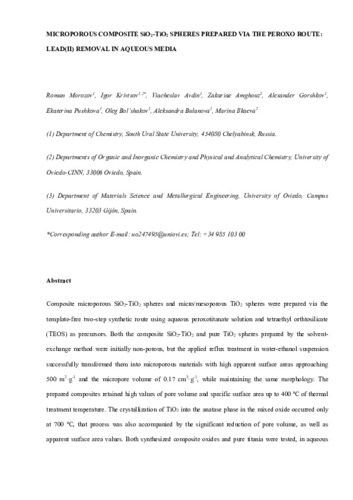Microporous composite SiO2-TiO2 spheres prepared via the peroxo route: Lead(II) removal in aqueous media
Subject:
SiO2TiO2
Spherical particles
Silica-titania
Microporous
Lead adsorption
Peroxo method
Publication date:
Publisher version:
Citación:
Descripción física:
Abstract:
Composite microporous SiO2-TiO2 spheres and micro/mesoporous TiO2 spheres were prepared via the template-free two-step synthetic route using aqueous peroxotitanate solution and tetraethyl orthosilicate (TEOS) as precursors. Both the composite SiO2-TiO2 and pure TiO2 spheres prepared by the solvent-exchange method were initially non-porous, but the applied reflux treatment in water-ethanol suspension successfully transformed them into microporous materials with high apparent surface areas approaching 500 m2·g− 1 and the micropore volume of 0.17 cm3·g− 1, while maintaining the same morphology. The prepared composites retained high values of pore volume and specific surface area up to 400 °C of thermal treatment temperature. The crystallization of TiO2 into the anatase phase in the mixed oxide occurred only at 700 °C, that process was also accompanied by the significant reduction of pore volume, as well as apparent surface area values. The prepared materials were tested as adsorbents for the lead(II) removal; they demonstrated high adsorption capacities, reaching 340 mg(Pb2 +)·g− 1. Moreover, the mixed silica-titania oxide was found to be more efficient adsorbent at low pH values.
Composite microporous SiO2-TiO2 spheres and micro/mesoporous TiO2 spheres were prepared via the template-free two-step synthetic route using aqueous peroxotitanate solution and tetraethyl orthosilicate (TEOS) as precursors. Both the composite SiO2-TiO2 and pure TiO2 spheres prepared by the solvent-exchange method were initially non-porous, but the applied reflux treatment in water-ethanol suspension successfully transformed them into microporous materials with high apparent surface areas approaching 500 m2·g− 1 and the micropore volume of 0.17 cm3·g− 1, while maintaining the same morphology. The prepared composites retained high values of pore volume and specific surface area up to 400 °C of thermal treatment temperature. The crystallization of TiO2 into the anatase phase in the mixed oxide occurred only at 700 °C, that process was also accompanied by the significant reduction of pore volume, as well as apparent surface area values. The prepared materials were tested as adsorbents for the lead(II) removal; they demonstrated high adsorption capacities, reaching 340 mg(Pb2 +)·g− 1. Moreover, the mixed silica-titania oxide was found to be more efficient adsorbent at low pH values.
Patrocinado por:
South Ural State University is grateful forfinancial support of theMinistry of Education and Science of the Russian Federation (grant No16.2674.2014/K). University of Oviedo gratefully acknowledgesfi-nancial support from the Spanish MINECO (MAT2013-40950-R andMAT2016-78155-C2-1-R). Igor Krivtsov thanks for the support theRussian Foundation for Basic Research 16-29-10757-ofi.
Collections
- Artículos [37354]
- Investigaciones y Documentos OpenAIRE [8231]
- Química Física y Analítica [628]
Files in this item





